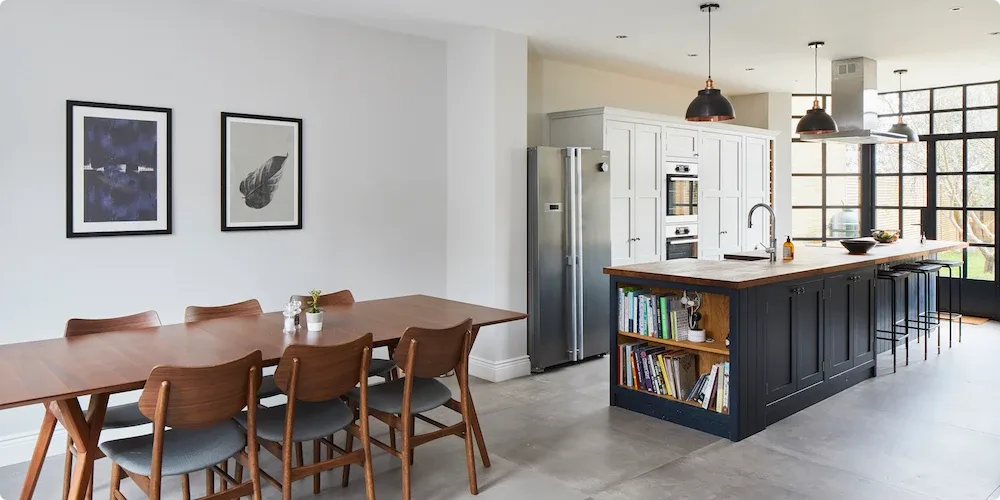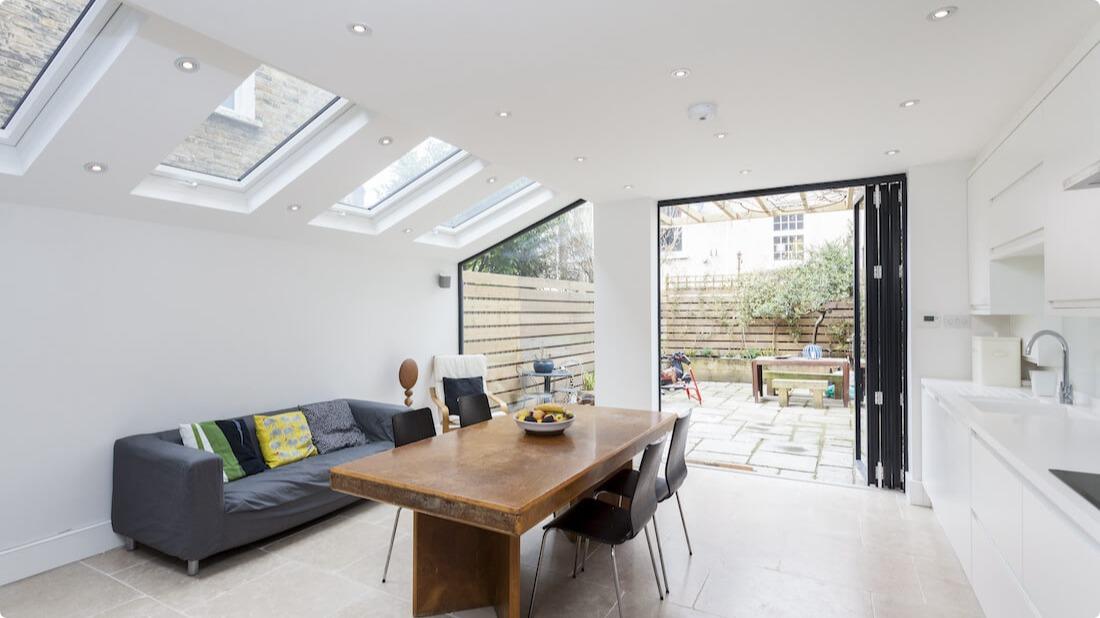Building a rear extension is an exciting yet often daunting prospect. Many homeowners don’t know where to start, who to talk to, or what to do first. However, as there are costs associated with every part of a rear extension project, knowing what needs to be taken into account before you start construction is imperative. For example, architects, planning permission applications, drain surveyors or structural engineers all come with associated fees separate from the construction of your rear extension.
If you’ve been trying to crunch the numbers of your dream extension but haven’t been able to nail down an accurate estimate, keep reading to learn just how much a rear extension in the UK can set you back.
What affects the price of a rear extension?
The cost of a rear extension can vary depending on several factors, such as:
- Your location in the UK (E.g. Construction is traditionally more expensive in London)
- The size of your extension (E.g. if it's single storey vs two storey)
- The complexity of the design (E.g. flat vs. pitched roofs)
- Each material required and its quality or quantity
- The building company you choose
NB: It’s worth bearing in mind what to consider when it comes to picking a builder (the price tag is just one factor!) One-man bands tend to offer cost-effective quotes; however, you’ll find choosing smaller companies come with a risk of delays and bad practices. Conversely, larger building contractor companies cost more BUT provide better value for your money in the long run, especially when they’re best equipped to deal with supply chain hold-ups and labour shortages.
Learn more about contractor types and how they can affect your budget.
Material and labour shortages
Several issues have affected the trade industry post-Covid-19, all of which may affect the cost of your project. Whether it’s VAT, suppliers suffering from delays, or labour shortages, we always recommended saving a 10% contingency fund to help you weather these issues.
Learn more: Material and labour shortages push up the cost of construction.
What costs do I need to factor into my budget?
While a large part of your budget will go towards construction and the materials involved in building your rear extension, there are other costs to consider.
For example, a typical budget is often split like this:
- Architect fees - 5% (based on Resi’s services)
- Administration fees - 1%
- Structural Engineers - 2%
- Surveyors - 2%
- Contractors - 30%
- Materials - 20%
- Fittings - 5%
- Glazing - 15%
- VAT – 20%
How much does a rear extension cost per square metre?
Based on an average rear extension size of 45m2, the average cost of a ground floor rear extension in London is between £85,500 and £135,000. For the rest of the UK, the average costs are between £74,250 and £117,000.
Taking these averages, you can work out the likely cost of your ground floor rear extension using our estimates below.
- £1900 = Average lowest cost per m2 of ground floor rear extensions in London and the South East
- £3000 = Average highest cost per m2 of ground floor rear extensions in London and the South East
- £1650 = Average lowest cost per m2 of ground floor rear extensions for the rest of the UK
- £2600 = Average highest cost per m2 of ground floor rear extensions for the rest of the UK
For example, if you’re planning on a small ground floor rear extension of 30m2, your build will likely cost between £57,000 and £90,000 in the London area.
So, why is there such a difference between the lowest and highest amounts? The final price depends entirely on the complexity of the build, such as the type of roof and finishes you want, the materials you use, and the building company you choose to construct your design.
NB: The m2 depicted is the total refurbished area, not just the additional space. For example, a 45m2 extension will typically add an extra 15m2 of space. Consequently, the above calculations include the room the extension is being attached to.
Do I need to hire an architect for my rear extension and how much do they cost?
Hiring an architect to build a rear extension in the UK isn’t a legal requirement. However, this doesn’t mean they’re not a worthwhile investment. Architects are highly qualified experts and offer plenty of benefits when it comes to renovating your home.
Architects cost between 5-10% of the build. Learn more: How much do architects cost?.
They help create beautiful and functional spaces
Rather than just following design trends, architects help you maximise your space and customise its layout. By taking a holistic overview, they’ll design a build that complements the unique way your family lives.
Your chance of planning success will increase
Architects bring their years of experience and expertise to your project, not only in design but in planning too. Chances are, they’ll have dealt with your local authority in the past and know how to approach planning and design in your area. This means you’re far more likely to secure planning permission with an architect than without one. For example, Resi’s planning team have a 92% success rate, which is currently unheard of in the industry.
Architects are useful for budget management
Resi’s architects make sure you’re crystal clear about our fees and any likely costs for external contractors (such as surveyors and structural engineers etc.) We’ll advise you on how much you’ll need for each stage of a project and when you’ll need to pay.
Not only that, but our finance parterns will help you explore your funding options to find the right way to pay for your home improvement project.
Discover the cost of an architect in minutes with our quick quote tool.
When do I need a structural engineer and how much do they cost?
Put simply, a structural engineer makes sure your home stays standing. As their name suggests, they look after the structural calculations required to optimise your property’s strength, rigidity and stability. They make sure it withstands any likely stress or pressure imposed on it, whether that’s through the materials they recommend or the way the building is erected.
A structural engineer will typically work on your project during the building regulations stage, which comes after planning, and their fees are anywhere between £950 and £2500.
Cost-cutting tips for your rear extension
Who hasn’t switched on Grand Designs and thought: ”I would love to do something like that if only I had the money”?
Thankfully, there are ways to make room in your budget for a high-end aesthetic and contemporary extension, as long as you know how to make your money work harder.
We’ve helped thousands of homeowners get the most out of their budgets at Resi, and now we’re revealing some of our top money-saving tips. After all, great style doesn’t always have to break the bank.
Save some money on the fittings you choose
Get the most out of your budget by knowing where to invest the big bucks and where to look for cheaper alternatives. One quick win is to carefully choose your fittings.
For example, if you’re renovating your kitchen, don’t spend all your money on bespoke taps from Germany or handcrafted cabinets from Sweden. These items will quickly depreciate in value due to their use.
 Designed by Resi
Designed by Resi
The owner of this extension (above image) opted to invest the bulk of their budget into classic features such as an exposed brick wall and a glass ceiling. Due to their popularity, these kinds of investments tend to pay off when selling a property, making them smart interior design choices. In short: they rarely depreciate in value.
However, to afford this finish, the homeowners bought their kitchen fittings from Ikea. Opting for a stylish yet straightforward black model – and one that could be jazzed up later on with some interior design touches – they transformed their space without breaking the bank.
Even so, remember not to cut corners on everything in your extension. Otherwise, you harm your future resale profits.
Stay structure savvy and avoid overly complex builds
Keeping your layout simple and the size reasonable saves a lot of money, especially when it comes to structural costs.
Long or large extensions require additional structural support, which involves the use of steel beams to avoid collapse. The bigger your extension, the bigger these beams become, meaning the costs start to rise until they add thousands to your budget.
At Resi, we always make sure our customers understand the structural costs when we put together their proposed designs. However, if you’re not using us, ask your architect to do the same so can double-check the price tag with your structural engineer when it comes to sorting out your building regulations.
Use clever concrete to save some pennies
Concrete floors are one of the biggest kitchen design trends in the interior design world right now. However, although a concrete floor creates a stylish and sturdy finish, pouring and curing it is both labour intensive and expensive.
That’s why we love these concrete tiles. They perfectly mimic the look of concrete and, thanks to their easy assembly, come in at half the price – win-win! Go a step further in the money-saving department and install the tiles yourself.
 Designed by Resi
Designed by Resi
Although tiles and laminate flooring have a bad reputation in some circles, good-quality materials mimic their more expensive counterparts. For example, quality laminate replaces hardwood floors and faux-marble tiles replace, well, marble tiles. They’re aesthetically pleasing and don’t force you to forgo style or class.
Fake it until you make it with faux Crittall
Created in 1860 by an Essex ironmonger called… you guessed it, Francis Henry Crittall, these steel-framed windows are timeless and distinguished. They’ve enjoyed a resurgence in popularity recently, all thanks to the stylish glass structures that blend metalwork and a glazed aesthetic.
However, as only one company produces this trademarked style of window, there’s a long waiting list and a large fee for their acquisition. So, what’s a homeowner to do?
 Designed by Resi
Designed by Resi
We recommend taking a look at one of the aluminium alternatives, which are slightly cheaper and just as striking. There’s no trademark involved either, meaning they’re more widely produced and enjoy quick turnaround times. Also, most people can’t differentiate between the real deal and the aluminium alternatives, making them a perfect substitute.
Swap a glass ceiling for a skylight
If you love the look of glass ceilings but don’t have the budget, consider the humble skylight, which is a cheaper alternative. You also don’t need to compromise on the level of natural light your rear extension enjoys if you install skylights in a row, as you can see in the image below.
Large glass features are typically built using structural glass, which ensures the safety and longevity of your design. However, it’s a costly material that often requires structural support in the surrounding walls too, such as steel beams and underpinning. Conversely, skylights come with cheaper material options and save you a lot of money while creating the same aesthetic.
 Designed by Resi
Designed by Resi
Why not use the money you save to invest in other glazed favourites such as large sliding doors or bi-fold entrances? They’re on-trend, budget-friendly, and offer extra light.
Looking for more design ideas for your rear extension? Book a free consultation with our experts to explore your options.























